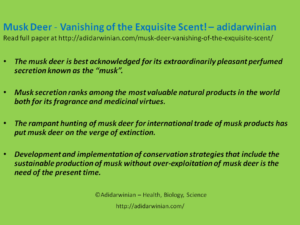This paper discusses the threatened condition of musk deer with focus on taxonomy of musk deer, distribution of musk deer, production of musk, uses of musk both as a perfume and medicine, trade of musk, and conservation status of musk deer. The author of this paper aims to emphasize the exquisiteness of the musk secretion both as a perfume and medicine, and hence, the need to save the musk deer from getting extinct.
The musk deer is best acknowledged for its extraordinarily pleasant perfumed secretion known as the musk. This secretion ranks among the most valuable natural products in the world both for its fragrance and medicinal virtues, and has played the most important role in the decline of the population of musk deer on this planet. The rampant hunting of musk deer for international trade of musk products has resulted in the vanishing of the exquisite scent at an accelerated rate.
Taxonomy / Classification of Musk Deer
Musk deer are deer-like animals belonging to the family Moschidae of the order Artiodactyla under the class Mammalia. The following species of musk deer (genus – Moschus) have been recognized, viz. –
Moschus moschiferus – It is also known as Siberian musk deer or Taiga musk deer.
M. berezovskii – It is also known as Forest musk deer, Chinese Forest musk deer, South China Forest musk deer, or Dwarf musk deer.
M. chrysogaster – It is also known as Alpine musk deer.
M. leucogaster – It is also recognized by the name of Himalayan musk deer.
M. cupreus – It is also recognized by the name of Kashmir musk deer.
M. anhuiensis – Moschus anhuiensis is also known as Anhui musk deer.
M. fuscus – Moschus fuscus is also recognized by the name of Black musk deer or Dusky musk deer. Continue reading
Continue reading
